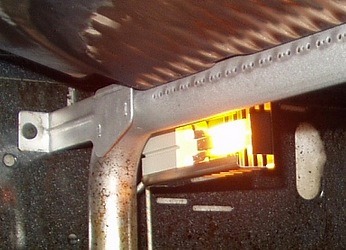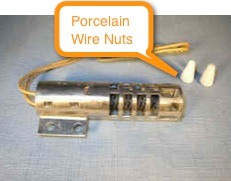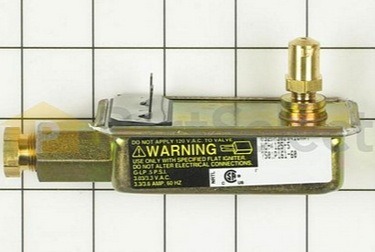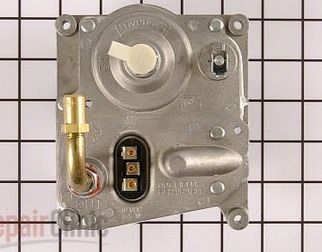Igniter Systems (See Sparkers below)
Most gas oven "will not bake" complaints are a result of a worn out bake igniter. The customer will complain:
1. "My oven will not get hot enough." "I smell gas." "My oven takes forever to get hot."
Nine times out of ten this means a bad igniter. This is easily verified by seeing if the igniter is glowing. If the answer is yes, replace it. It's as simple as that. Igniters grow old and dim and no longer draw enough current to fully open the gas valve. Details of this logic are in my Oven Manual.

Hot Igniter Square Style
A dead igniter, no glow at all, raises other possibilities that need to be checked.
1. Remove the old igniter far enough to check it for continuity. It may be cracked. This will be the most likely case.

Round Style Oven Igniter
2. Inspect the high temperature wiring to the igniter. This may be the culprit, especially if the igniter was repaired improperly before and the wiring burned off. Always use porcelain wire nuts; plastic ones will melt.
3. Make certain that the controls are properly set.
4. Check for 110VAC across the entire gas valve and igniter circuit. If no 110VAC is present find out why.
5. Check for the presence of gas. Don't make a fool of yourself. Test the top burners or other appliances to see if any have gas.
6. Check continuity of the gas valve with an ohmmeter. (Do not apply 110VAC to the valve, it will ruin it)

Standard Bi-metal Gas Valve
It is unusual for either a gas ERC or a gas valve to fail. The funny thing is that parts stores sell a lot of gas valves to the ill informed. Its always the igniter!!!
Sparker Gas Valve Systems
Later model Whirlpool ovens use a sparker instead of a glow igniter to lite the gas. This gas valve for this design does not utilize a bi-metal heater to open the valve. Rather it uses a solenoid similar to that used on dryer gas systems. The primary difference it that the coils are inside the valve and inaccessible. The valve itself looks much like the bi-metal one. The solenoids within the valve and can be effectively tested with an ohmmeter. Also see "Oven Temperature Not Right".

Whirlpool Accubake Solenoid Gas Valve